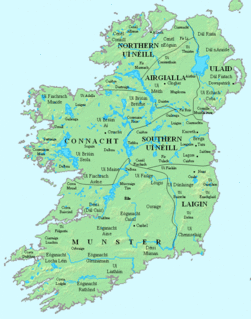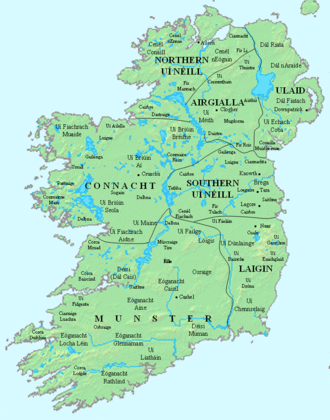
West Connacht was a kingdom of Gaelic Ireland, associated geographically with present-day County Galway, particularly the area known more commonly today as Connemara. The kingdom represented the core homeland of the Connachta's Uí Briúin Seóla kindred and although they ruled, there were smaller groups of other Gaels in the area, such as the Delbhna Tir Dha Locha and the Conmhaícne Mara. It existed from 1051 onwards, after the Ó Conchobhair, Kings of Connacht, pushed the Ó Flaithbheartaigh to the West of Lough Corrib, from their original territory of Maigh Seóla. Iar Connacht remained a subordinate túath of Connacht, until the 13th century, after which it was more independent.

Maigh Seóla, also known as Hy Briuin Seola, was the territory that included land along the east shore of Lough Corrib in County Galway, Ireland. It was bounded to the east by the Uí Maine vassal kingdom of Soghain and extended roughly from what is now Clarinbridge in the south to Knockmaa Hill in the north. Its rulers belonged to the Uí Briúin Seóla and are sometimes found in the annals under the title "King of Uí Briúin" and "King of South Connacht". The earliest identifiable kings belonged to the line that became the Clann Cosgraigh. However in later times the line which would become the Muintir Murchada, under the O'Flaherty chiefs, monopolized the kingship.

The Delbna or Delbhna were a Gaelic Irish tribe in Ireland, claiming kinship with the Dál gCais, through descent from Dealbhna son of Cas. Originally one large population, they had a number of branches in Connacht, Meath, and Munster in Ireland.

O'Flaherty, is an Irish Gaelic clan based most prominently in what is today County Galway. The clan name originated in the 10th century as a derivative of its founder Flaithbheartach mac Eimhin. They descend in the paternal line from the Connachta's Uí Briúin Seóla. They were originally kings of Maigh Seóla and Muintir Murchada and as members of the Uí Briúin were kinsmen of the Ó Conchubhair and Mac Diarmada amongst others. After their king Cathal mac Tigernán lost out to Áed in Gai Bernaig in the 11th century, the family were pushed further west to Iar Connacht, a territory associated with Connemara today. They continued to rule this land until the 16th century. The name has been alternatively rendered into English in various forms, such as Flaherty, Faherty, Laverty, Flaverty, Lahiff, and Flahive.
The Soghain were a people of ancient Ireland. The 17th century scholar Dubhaltach Mac Fhirbhisigh identified them as part of a larger group called the Cruithin. Mac Fhirbhisig stated that the Cruithin included "the Dál Araidhi [Dál nAraidi], the seven Lóigisi [Loígis] of Leinster, the seven Soghain ... and every Conaille ... "
Cathal mac Conchobair was King of Connacht.

The Uí Briúin were a royal dynasty of Connacht. Their eponymous apical ancestor was Brión, son of Eochaid Mugmedon and Mongfind, and an elder half brother of Niall of the Nine Hostages. They formed part of the Connachta, along with the Uí Fiachrach and Uí Ailello, putative descendants of Eochaid Mugmedon's sons Fiachra and Ailill. The Uí Ailello were later replaced as the third of the Three Connachta, through genealogical sleight of hand, by the Uí Maine.

Senchineoil or Seincheinéal was the name of the early rulers, possibly pre-Gaelic, of what is now central and east County Galway and south County Roscommon, Ireland.
Indrechtach mac Muiredaig Muillethan was a King of Connacht from the Uí Briúin branch of the Connachta. He was the son of Muiredach Muillethan mac Fergusso, a previous king. He was of the Síl Muiredaig sept of the Uí Briúin.
Ruaidrí Ua Conchobair, called Ruaidrí na Saide Buide was King of Connacht, perhaps twice.
Conchobar mac Taidg Mór was a King of Connacht from the Uí Briúin branch of the Connachta. He was the grandson of Muirgius mac Tommaltaig, a previous king. His father Tadg Mór had been slain fighting in Muirgius' wars versus the minor tribes of Connacht. He was of the Síl Muiredaig sept of the Uí Briúin. The Ó Conchobhair septs of Connacht are named for him.
Tadg mac Conchobair was a King of Connacht from the Uí Briúin branch of the Connachta. He was the son of Conchobar mac Taidg Mór, a previous king, the second of his three sons to rule in succession, succeeding his brother Áed mac Conchobair. He was of the Síl Muiredaig sept of the Uí Briúin. He ruled from 888-900.
Diarmait mac Tommaltaig was a king of Connacht from the Uí Briúin branch of the Connachta. He was the great-grandson of Indrechtach mac Muiredaig Muillethan, a previous king. The death of his father Tommaltach mac Murgail is recorded in the annals where he is called king of Mag nAi. He succeeded his brother Muirgius mac Tommaltaig. He was of the Síl Muiredaig sept of the Uí Briúin. He ruled from 815 to 833.

Uí Díarmata was a local kingdom located in what is now north County Galway.
The Conmhaícne Mheáin Maigh or Conmaicne Mhein or Conmaicne Máenmaige or Conmaicne Críche Meic Erca, were an early people of Ireland, their tuath comprising the barony of Loughrea, in County Galway.

Clann Fhergail was a cantred located in County Galway, comprising the baronies of Moycullen and Galway, the parishes of Oranmore and Ballynacourty and Rahoon.
Tadhg mac Muircheartach was the first recorded king of Uí Díarmata, a local kingdom located in what is now north County Galway, Ireland, who died in 971.
Fearghal Ó Taidg an Teaghlaigh, Chief of the Name, Marshal and bodyguard of King Cathal Crobhdearg Ua Conchobair of Connacht and his successor, Aedh, died 1226.
Creassa inion Urchadh Princess of the Uí Briúin Seóla and Queen of Connacht, fl. early 10th century.
Caineach inion Urchadh Princess of the Uí Briúin Seóla and Queen of Connacht, fl. early 10th century.



